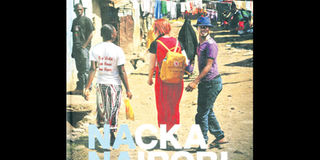Book captures enchanting stories of Stockholm and Nairobi

Nacka Nairobi is neither a picture book per se nor are the numerous full page photos that make up much of its content the works of professionals. Published in Swedish and English, Nacka Nairobi is, as the subtitle states, a combination of compelling photographs and enchanting stories from Nairobi and Stockholm. PHOTO | NATION
What you need to know:
- What would possibly bring together youths from crime-prone slum areas in a fast growing third world city and those from a suburb in a modern European city?
- Nothing, in all probability. Not until a certain high school teacher from Sweden came to Kenya towards the end of the year 2007 and visited the Korogocho slums, where he met a local man passionate about working with the youth for self-empowerment.
Book Review: Nacka Nairobi
Publisher: MediaGymnasiet Nacka Strand
The curious choice of title Nacka Nairobi aside, from a casual read-through, the not so avid reader would be forgiven for thinking that this is merely a well-bound travel picture book.
Yet, Nacka Nairobi is neither a picture book per se nor are the numerous full page photos that make up much of its content the works of professionals.
Published in Swedish and English, Nacka Nairobi is, as the subtitle states, a combination of compelling photographs and enchanting stories from Nairobi and Stockholm.
Which poses the question, what does Nairobi and Stockholm have in common that informed the collaborative efforts of the various youthful authors and photographers?
Or perhaps, to paraphrase, what would possibly bring together youths from crime-prone slum areas in a fast growing third world city and those from a suburb in a modern European city? Nothing, in all probability. Not until a certain high school teacher from Sweden came to Kenya towards the end of the year 2007 and visited the Korogocho slums, where he met a local man passionate about working with the youth for self-empowerment.
The two hit it off instantly and met a few months later in Stockholm, where they conceived the idea of an exchange programme between a school where the Swedish man worked and another one thousands of miles away in Kariobangi, Nairobi.
POSITIVE IMPACT
Six years on and a select group of young people drawn from contrasting social backgrounds have bridged the gap between the two cities and forged an unlikely social bond through the Nacka Nairobi Initiative, as aptly documented in a book.
Since the initiative’s inception, more than 60 teachers and students from Our Lady of Fatima Secondary School in Kariobangi and MediaGymnasiet, a media high school in Stockholm, Sweden, have participated in the exchange programme.
The travels between Kenya and Sweden has been most rewarding for these youth in the sense that they have afforded them a once-in-a-lifetime chance to experience cross-cultural interaction with their peers from a very different geographic zone, while at the same time prompting other projects.
Nacka Nairobi is all about the positive impact of this cultural exchange programme that has opened the world views of those students who have been lucky enough to get involved.
The book largely contains photographs and write ups that portray the streets of the two cities, homes and families of some of the students and the projects that have been initiated as a result.
In one of the chapters of the book, some 15 students who have benefited from the programme recount their experiences and the lasting memories they hold from trips abroad.
The contrast in the narration of their personal experiences can’t be sharper, yet, as one of the beneficiaries of the programme, Sofia Modig, puts it in her own words, there are many similarities between Kenyan and Swedish youths irrespective of their varied cultural backgrounds.
To many of the Kenyan students, the exchange has led to further studies and new opportunities to pursue careers in the media.
A significant upshot of this collaboration is the K-Youth Media Center in Nairobi which offers training in film production, photography and journalism.
If the hard cover copy of Nacka Nairobi was to be judged by its aesthetic outlook — in contravention of the old adage of not judging a book by its cover — then the publication would easily qualify for the first-rate category.
This is in spite of the obvious challenges that publishing in two languages under the same cover poses.




